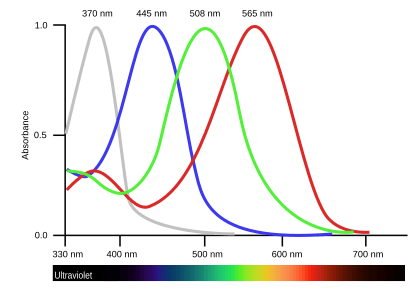Tetrachromacy facts for kids

Tetrachromacy is the condition of possessing four independent channels for conveying color information, or possessing four types of cone cell in the eye. Organisms with tetrachromacy are called tetrachromats.
In tetrachromatic organisms, the sensory color space is four-dimensional, meaning that matching the sensory effect of arbitrarily chosen spectra of light within their visible spectrum requires mixtures of at least four primary colors.
Tetrachromacy is demonstrated among several species of bird, fish, amphibian, reptile, insect, and some mammals. It was the normal condition of most mammals in the past; a genetic change made the majority of species of this class eventually lose two of their four cones.
Physiology
The normal explanation of tetrachromacy is that the organism's retina contains four types of higher-intensity light receptors (called cone cells in vertebrates as opposed to rod cells, which are lower-intensity light receptors) with different absorption spectra. This means that the organism may see wavelengths beyond those of a typical human's vision, and may be able to distinguish between colors that, to a normal human, appear to be identical. Species with tetrachromatic color vision may have an unknown physiological advantage over rival species.
Examples
Fish
The goldfish (Carassius auratus auratus) and zebrafish (Danio rerio) are examples of tetrachromats, containing cone cells sensitive for red, green, blue and ultraviolet light.
Birds
Some species of birds, such as the zebra finch and the Columbidae, use the ultraviolet wavelength 300–400 nm specific to tetrachromatic color vision as a tool during mate selection and foraging. When selecting for mates, ultraviolet plumage and skin coloration show a high level of selection. A typical bird eye responds to wavelengths from about 300 to 700 nm. In terms of frequency, this corresponds to a band in the vicinity of 430–1000 THz. Most birds have retinas with four spectral types of cone cell that are believed to mediate tetrachromatic color vision. Bird color vision is further improved by filtering by pigmented oil droplets in the photoreceptors. The oil droplets filter incident light before it reaches the visual pigment in the outer segments of the photoreceptors.
The four cone types, and the specialization of pigmented oil droplets, give birds better color vision than that of humans. However, more recent research has suggested that tetrachromacy in birds only provides birds with a larger visual spectrum than that in humans (humans cannot see ultraviolet light, 300-400 nm), while the spectral resolution (the "sensitivity" to nuances) is similar.
Insects
Foraging insects can see wavelengths that flowers reflect (ranging from 300 nm to 700 nm). Pollination being a mutualistic relationship, foraging insects and some plants have coevolved, both increasing wavelength range: in perception (pollinators), in reflection and variation (flower colors). Directional selection has led plants to display increasingly diverse amounts of color variations extending into the ultraviolet color scale, thus attracting higher levels of pollinators.
Mammals
Mice, which normally have only two cone pigments, can be engineered to express a third cone pigment, and appear to demonstrate increased chromatic discrimination, arguing against some of these obstacles; however, the original publication's claims about plasticity in the optic nerve have also been disputed.
Reindeer
In areas where reindeer live, the sun remains very low in the sky for long periods. Some parts of the environment absorb ultraviolet light and therefore to UV-sensitive reindeer, strongly contrast with the UV-reflective snow. These include urine (indicating predators or competitors), lichens (a food source) and fur (as on wolves, predators of reindeer). Although reindeer do not possess a specific UV opsin, retinal responses to 330 nm have been recorded, mediated by other opsins. It has been proposed that UV flashes on power lines are responsible for reindeer avoiding power lines because "...in darkness these animals see power lines not as dim, passive structures but, rather, as lines of flickering light stretching across the terrain."
Humans
Apes (including humans) and Old World monkeys normally have three types of cone cell and are therefore trichromats. However, at low light intensities, the rod cells may contribute to color vision, giving a small region of tetrachromacy in the color space; human rod cells' sensitivity is greatest at a bluish-green wavelength.
In humans, two cone cell pigment genes are present on the X chromosome: the classical type 2 opsin genes OPN1MW and OPN1MW2. People with two X chromosomes could possess multiple cone cell pigments, perhaps born as full tetrachromats who have four simultaneously functioning kinds of cone cell, each type with a specific pattern of responsiveness to different wavelengths of light in the range of the visible spectrum. One study suggested that 15% of the world's women might have the type of fourth cone whose sensitivity peak is between the standard red and green cones, giving, theoretically, a significant increase in color differentiation. Another study suggests that as many as 50% of women and 8% of men may have four photopigments and corresponding increased chromatic discrimination compared to trichromats. In 2010, after twenty years of study of women with four types of cones (non-functional tetrachromats), neuroscientist Gabriele Jordan identified a woman (subject cDa29) who could detect a greater variety of colors than trichromats could, corresponding with a functional tetrachromat (or true tetrachromat).
Variation in cone pigment genes is wide-spread in most human populations, but the most prevalent and pronounced tetrachromacy would derive from female carriers of major red/green pigment anomalies, usually classed as forms of "color blindness" (protanomaly or deuteranomaly). The biological basis for this phenomenon is X-inactivation of heterozygotic alleles for retinal pigment genes, which is the same mechanism that gives the majority of female new-world monkeys trichromatic vision.
In humans, preliminary visual processing occurs in the neurons of the retina. It is not known how these nerves would respond to a new color channel, that is, whether they could handle it separately or just combine it in with an existing channel. Visual information leaves the eye by way of the optic nerve; it is not known whether the optic nerve has the spare capacity to handle a new color channel. A variety of final image processing takes place in the brain; it is not known how the various areas of the brain would respond if presented with a new color channel.
Although many birds are tetrachromats with a fourth color in the ultraviolet, humans cannot see ultraviolet light directly because the lens of the eye blocks most light in the wavelength range of 300–400 nm; shorter wavelengths are blocked by the cornea. The photoreceptor cells of the retina are sensitive to near ultraviolet light, and people lacking a lens (a condition known as aphakia) see near ultraviolet light (down to 300 nm) as whitish blue, or for some wavelengths, whitish violet, probably because all three types of cones are roughly equally sensitive to ultraviolet light; however, blue cone cells are slightly more sensitive.
Tetrachromacy may also enhance vision in dim lighting, or when looking at a screen.
See also
 In Spanish: Tetracromatismo para niños
In Spanish: Tetracromatismo para niños
- Trichromacy
- Mantis shrimp (dodecachromats)
- Evolution of color vision


